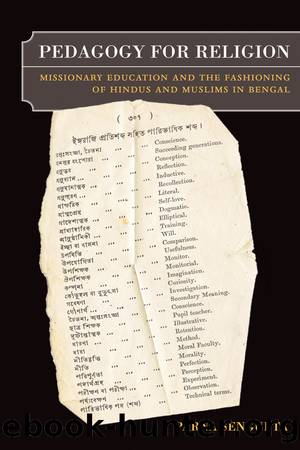Pedagogy for Religion by Parna Sengupta

Author:Parna Sengupta
Language: eng
Format: epub
Publisher: University of California Press
Published: 2012-01-22T16:00:00+00:00
THE DHAKA NORMAL SCHOOL
In 1862, the DPI opened the first womenâs teacher-training institution in Bengal, the Dhaka Normal School, and actively recruited Bairagi women (who belonged to a heterodox Vaishnavite sect) as students. The officials in the DPI perceived Bairagi women as appropriate teacher trainees because they were willing to be educated and work unhampered by the pardah restrictions of caste society. However, as I trace in this section, the changing gender and sexual norms within upper-caste society prompted various members of the bhadra classes to equate the Bairagi womenâs lower-caste status, mendicant lifestyle, and heterodox religious practices with âdeviantâ sexual behavior, ultimately complicating the DPIâs effort to transform them into ârespectableâ women teachers.
In precolonial India, as in much of the world, the most likely place for any female literary production (especially songs and poetry) was within religious contexts. The Vaishnava mendicant women, the Bairagi, were exceptional because they were also literate. Vaishnavites preached a religious message of salvation through devotion, particularly for those excluded from high-caste Hinduism: the lower castes and women. As historian Tanika Sarkar points out in Words to Win, Vaishnavism had an ambivalent relationship to textual knowledge and literacy, exemplified in the life of Sri Caitainya, the fourteenth-century founder of the movement: âChaitanya himself had mastered the path of knowledge, had transcended and had left it behind for simple faith and love. His devotees need not repeat the effort, they may adhere to the end product of the long process. The explicit message is, nonetheless, undercut by the medium through which it is communicated[:] a learned theological tome. This instantiates the paradoxical relationship between knowledge and unlearned faith that is forever unresolved in Vaishnavism. For we have here texts that are meant to be readâand not by pandits alone, but by the common folk.â24
The contradictory message of Vaishnavism encouraged the growth of heterodox sects and opened up space for literacy among the popular classes. But there were significant differences in the views toward female literacy between high and low Vaishnava communities in rural Bengal.25 While upper-caste Vaishnavites had many of the same devotional practices as the lower castes, they did not share any of the radical critique of the initial movement. High-caste Vaishnavite families were as socially orthodox as their fellow non-Vaishnavite Hindus and were reluctant to allow their wives, sisters, and daughters to read. It was commonly believed among high-caste Hindu families that literacy would lead to widowhoodâthat a woman could literally kill her husband by learning to read.
But the presence of lower-caste, literate Bairagi women in Dhaka drew the interest of the school inspector for southeastern Bengal, Mr. Martin. He felt that Dhaka, the home of many âprogressiveâ Bengali bhadralok, would be a good place to set up a normal school to train teachers. In late 1864, Martin wrote to the DPI that he had located women who were willing to attend the school and be trained as teachers. Martin related the correspondence between himself and the department. âIn reply [to the letter] you
Download
This site does not store any files on its server. We only index and link to content provided by other sites. Please contact the content providers to delete copyright contents if any and email us, we'll remove relevant links or contents immediately.
The Art of Coaching Workbook by Elena Aguilar(48065)
Trainspotting by Irvine Welsh(20055)
Twilight of the Idols With the Antichrist and Ecce Homo by Friedrich Nietzsche(17705)
Fangirl by Rainbow Rowell(7834)
Periodization Training for Sports by Tudor Bompa(7328)
Change Your Questions, Change Your Life by Marilee Adams(6641)
This Is How You Lose Her by Junot Diaz(5772)
Grit by Angela Duckworth(4737)
Red Sparrow by Jason Matthews(4666)
Asking the Right Questions: A Guide to Critical Thinking by M. Neil Browne & Stuart M. Keeley(4574)
Paper Towns by Green John(4169)
Room 212 by Kate Stewart(4107)
Ken Follett - World without end by Ken Follett(3972)
The Sports Rules Book by Human Kinetics(3588)
Housekeeping by Marilynne Robinson(3401)
The Motorcycle Diaries by Ernesto Che Guevara(3332)
Introduction to Kinesiology by Shirl J. Hoffman(3301)
Exercise Technique Manual for Resistance Training by National Strength & Conditioning Association(3291)
Double Down (Diary of a Wimpy Kid Book 11) by Jeff Kinney(3272)
